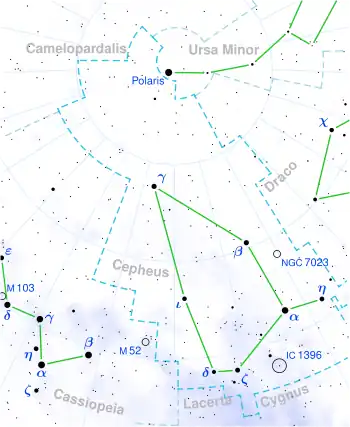Zeta Cephei
Zeta Cephei (ζ Cep, ζ Cephei) is a star in the constellation of Cepheus. Zeta Cephei marks the left shoulder of Cepheus, the King of Joppa (Ethiopia). It is one of the fundamental stars of the MK spectral sequence, defined as type K1.5 Ib.
 | |
| Observation data Epoch J2000 Equinox J2000 | |
|---|---|
| Constellation | Cepheus |
| Right ascension | 22h 10m 51.279s[1] |
| Declination | +58° 12′ 04.53″[1] |
| Apparent magnitude (V) | 3.35[2] |
| Characteristics | |
| Spectral type | K1.5 Ib[3] |
| B−V color index | +1.55[2] |
| Variable type | Eclipsing binary?[4] |
| Astrometry | |
| Proper motion (μ) | RA: 12.654 ± 0.4618[1] mas/yr Dec.: 5.989 ± 0.835[1] mas/yr |
| Parallax (π) | 3.2972 ± 0.1456 mas[5] |
| Distance | 990 ± 40 ly (300 ± 10 pc) |
| Absolute magnitude (MV) | −4.7[6] |
| Details | |
| Radius | 94[7] R☉ |
| Luminosity | 2,228 - 2,249[7] L☉ |
| Surface gravity (log g) | 0.75[8] cgs |
| Temperature | 4,072±170[7] K |
| Metallicity [Fe/H] | +0.22[8] dex |
| Rotational velocity (v sin i) | 10.64[9] km/s |
| Other designations | |
| Database references | |
| SIMBAD | data |
Zeta Cephei is an orange supergiant star with a surface temperature of 3,853 K and eight times more massive than the Sun. The luminosity of Zeta Cephei is approximately 3,600 times that of the Sun. At a distance of about 840 light-years,[10] Zeta Cephei has an apparent magnitude (m) of 3.4 and an absolute magnitude (M) of -4.7. The star has a metallicity approximately 1.6 times that of the Sun; i.e., it contains 1.6 times as much heavy-element material as the Sun.
Hekker et al. (2008) have detected a periodicity of 533 days, hinting at the possible presence of an as yet unseen companion.[11] It is listed as a possible eclipsing binary with a very small amplitude.[4]
At the edge of the 8 to 10 solar mass (M☉) limit at which stars develop iron cores and then explode as supernovae, Zeta Cephei's most likely fate is to produce a very massive white dwarf near the Chandrasekhar limit (1.4 M☉) at which such dense remnants can survive. If Zeta Cephei is a binary star; i.e., if there is a stellar companion, and it is close enough to feed sufficient matter to the white-dwarf-to-be, it is marginally possible that the limit could be overflowed, resulting in the white dwarf's collapse and a Type Ia supernova explosion.
References
- Brown, A. G. A.; et al. (Gaia collaboration) (August 2018). "Gaia Data Release 2: Summary of the contents and survey properties". Astronomy & Astrophysics. 616. A1. arXiv:1804.09365. Bibcode:2018A&A...616A...1G. doi:10.1051/0004-6361/201833051. Gaia DR2 record for this source at VizieR.
- Levesque, Emily M.; Massey, Philip; Olsen, K. A. G.; Plez, Bertrand; Josselin, Eric; Maeder, Andre; Meynet, Georges (2005). "The Effective Temperature Scale of Galactic Red Supergiants: Cool, but Not As Cool As We Thought". The Astrophysical Journal. 628 (2): 973–985. arXiv:astro-ph/0504337. Bibcode:2005ApJ...628..973L. doi:10.1086/430901. S2CID 15109583.
- Morgan, W. W.; Keenan, P. C. (1973). "Spectral Classification". Annual Review of Astronomy and Astrophysics. 11: 29–50. Bibcode:1973ARA&A..11...29M. doi:10.1146/annurev.aa.11.090173.000333.
- Samus, N. N.; Durlevich, O. V.; et al. (2009). "VizieR Online Data Catalog: General Catalogue of Variable Stars (Samus+ 2007–2013)". VizieR On-line Data Catalog: B/GCVS. Originally Published in: 2009yCat....102025S. 1: 02025. Bibcode:2009yCat....102025S.
- Brown, A. G. A.; et al. (Gaia collaboration) (2021). "Gaia Early Data Release 3: Summary of the contents and survey properties". Astronomy & Astrophysics. 649: A1. arXiv:2012.01533. Bibcode:2021A&A...649A...1G. doi:10.1051/0004-6361/202039657. S2CID 227254300. (Erratum: doi:10.1051/0004-6361/202039657e). Gaia EDR3 record for this source at VizieR.
- Luck, R. E. (1982). "The chemical composition of late-type supergiants. IV - Homogeneous abundances and galactic metallicity trends". Astrophysical Journal. 256: 177. Bibcode:1982ApJ...256..177L. doi:10.1086/159895.
- Messineo, M.; Brown, A. G. A. (2019). "A Catalog of Known Galactic K-M Stars of Class I Candidate Red Supergiants in Gaia DR2". The Astronomical Journal. 158 (1): 20. arXiv:1905.03744. Bibcode:2019AJ....158...20M. doi:10.3847/1538-3881/ab1cbd. S2CID 148571616.
- Mallik, Sushma V. (December 1999), "Lithium abundance and mass", Astronomy and Astrophysics, 352: 495–507, Bibcode:1999A&A...352..495M
- Hekker, S.; Meléndez, J. (2007). "Precise radial velocities of giant stars. III. Spectroscopic stellar parameters". Astronomy and Astrophysics. 475 (3): 1003. arXiv:0709.1145. Bibcode:2007A&A...475.1003H. doi:10.1051/0004-6361:20078233. S2CID 10436552.
- van Leeuwen, F. (2007). "Validation of the new Hipparcos reduction". Astronomy and Astrophysics. 474 (2): 653–664. arXiv:0708.1752. Bibcode:2007A&A...474..653V. doi:10.1051/0004-6361:20078357. S2CID 18759600.Vizier catalog entry
- Hekker; et al. (2008). "Precise radial velocities of giant stars. IV. A correlation between surface gravity and radial velocity variation and a statistical investigation of companion properties". Astronomy and Astrophysics. 480 (1): 215–222. arXiv:0801.0741. Bibcode:2008A&A...480..215H. doi:10.1051/0004-6361:20078321. S2CID 33442610.